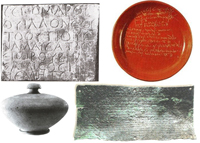- Introduction
- Further information

In the Mediterranean basin, during the second Iron Age, three Continental Celtic languages were written:
• Lepontic
“Celtiberian” is the language spoken by Celts from Spain. If their presence was certain as early as the 4th c. BC, their language is only attested from the 2nd c. BC. It seemed to be written and spoken consistently but only in certain areas.
The main originality of these inscriptions lies in the use of semi-syllabic Iberian writing to transcribe an Indo-European language for which it was absolutely not suitable (from the Latin writer's and reader's point of view). There were two graphic variants in the Celtiberian inscriptions; some were also written using the Latin alphabet.
• Gaulish
Traditionally it is said that the Gaulish did not know how to write. This is absolutely false; on the contrary, the Gaulish language is attested by many inscriptions written using no less than three different writing systems:
- the Etruscan alphabet, leading to Gallo-Etruscan;
- the Greek alphabet, more precisely Phocean alphabet, leading to Gallo-Greek;
- the Latin alphabet, leading to Gallo-Latin.
Go to the online resources.
Online resourcesList of symbols
Examples of writing
Bibliography
